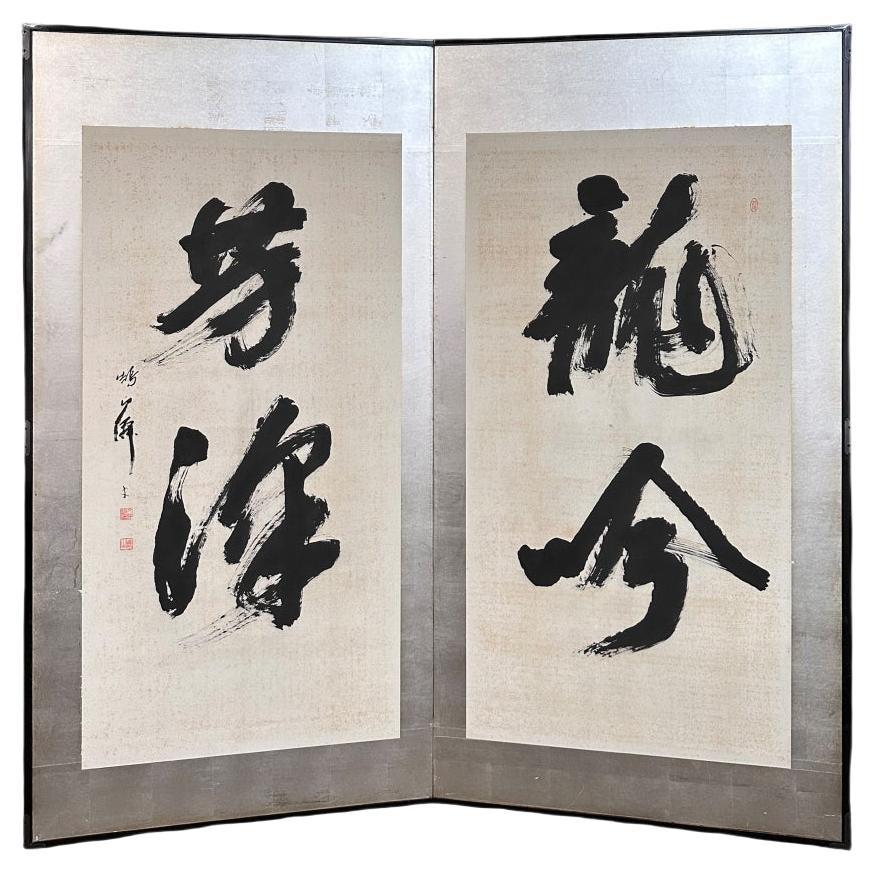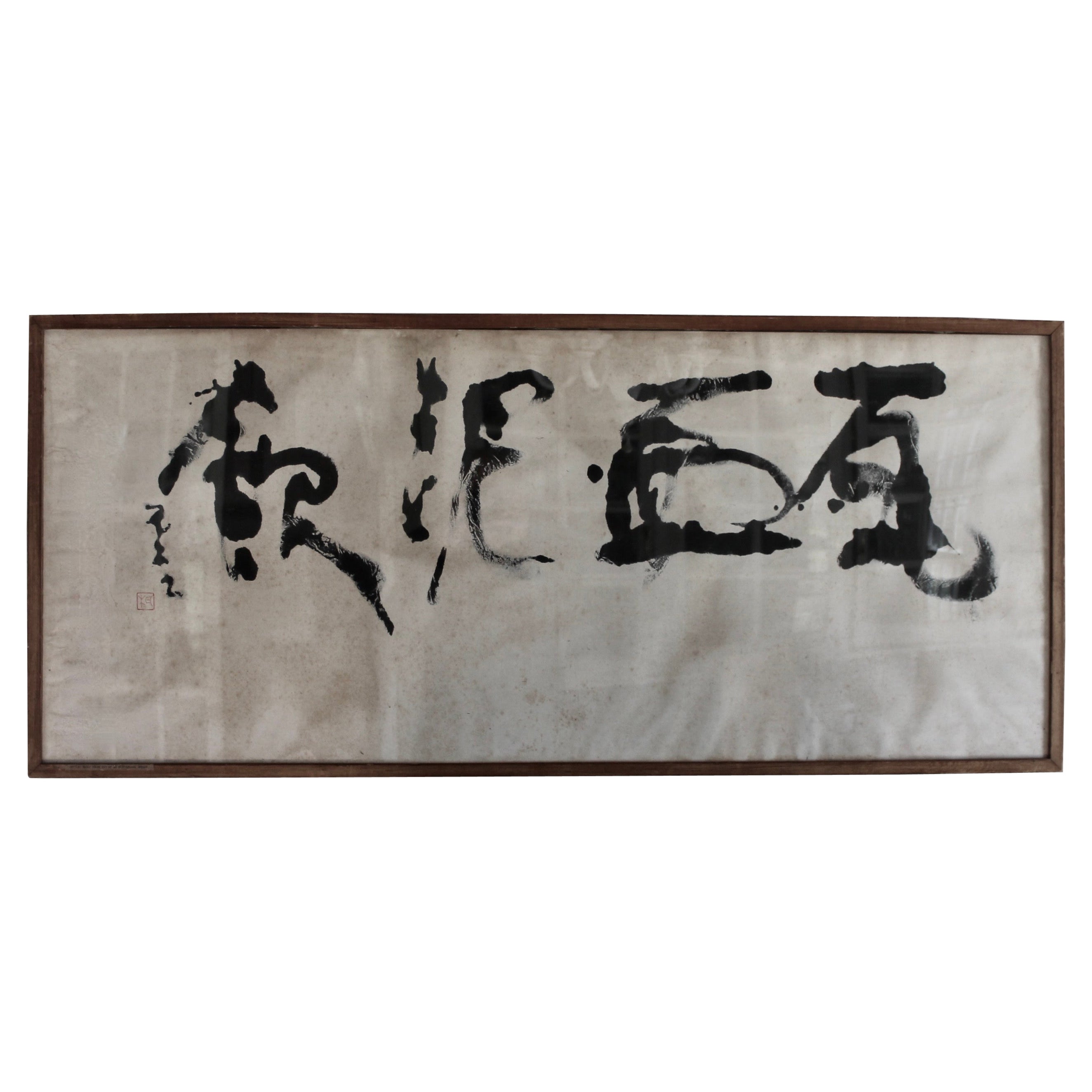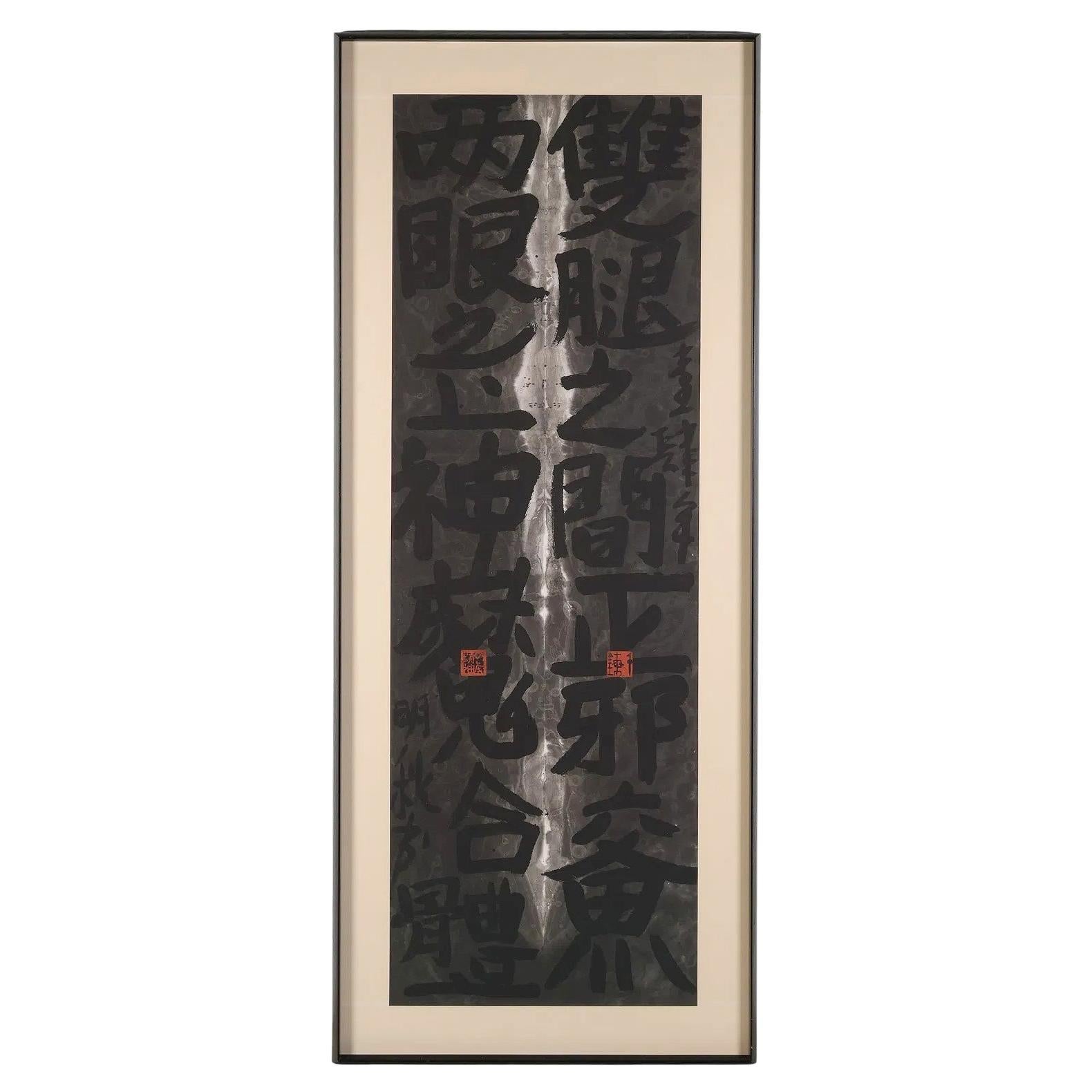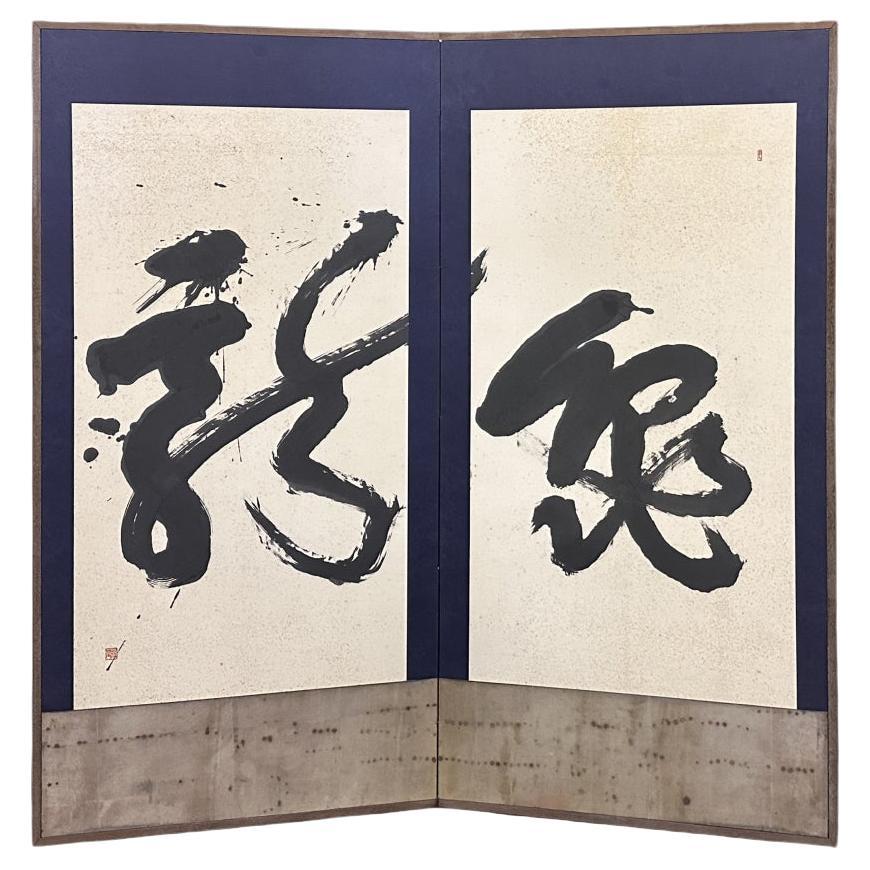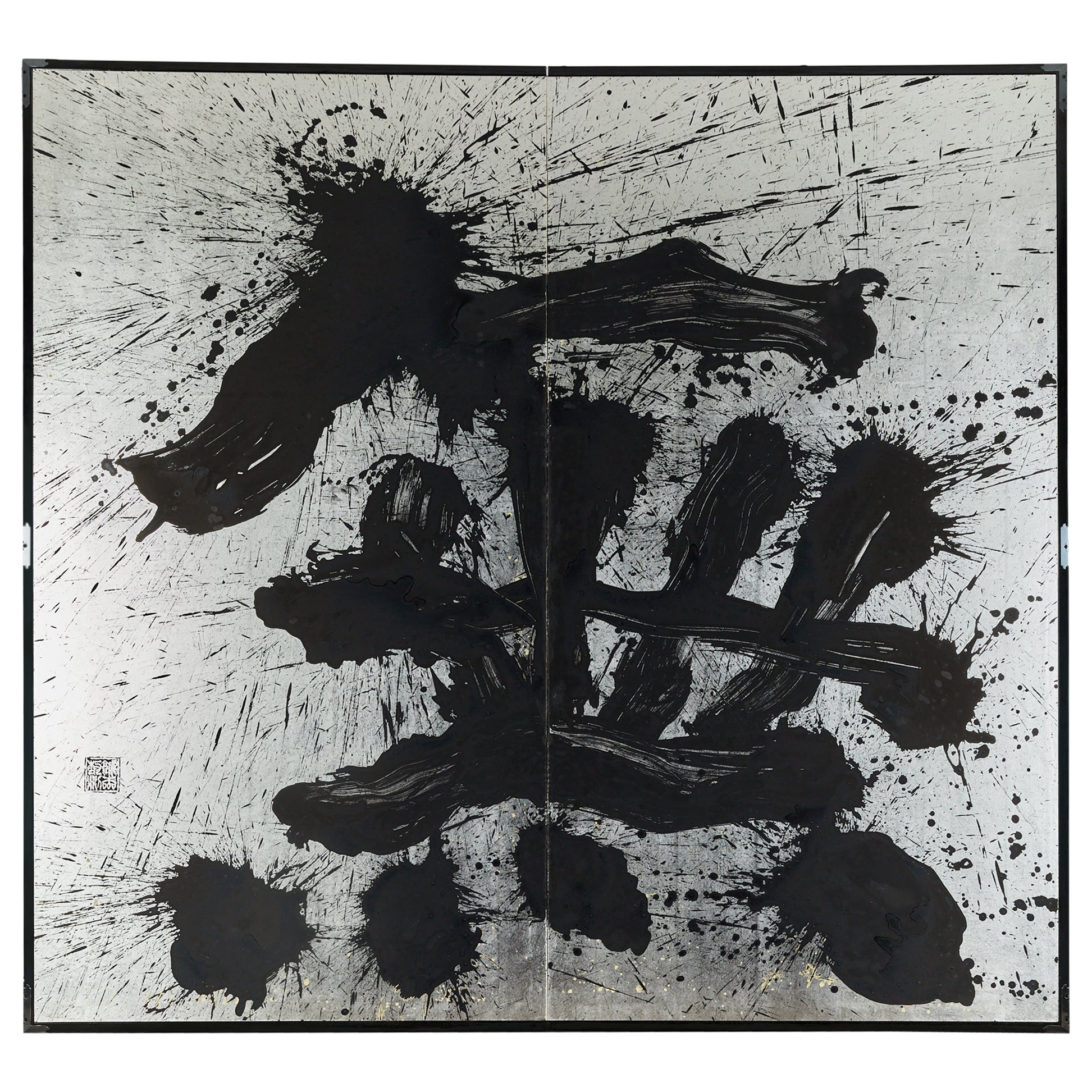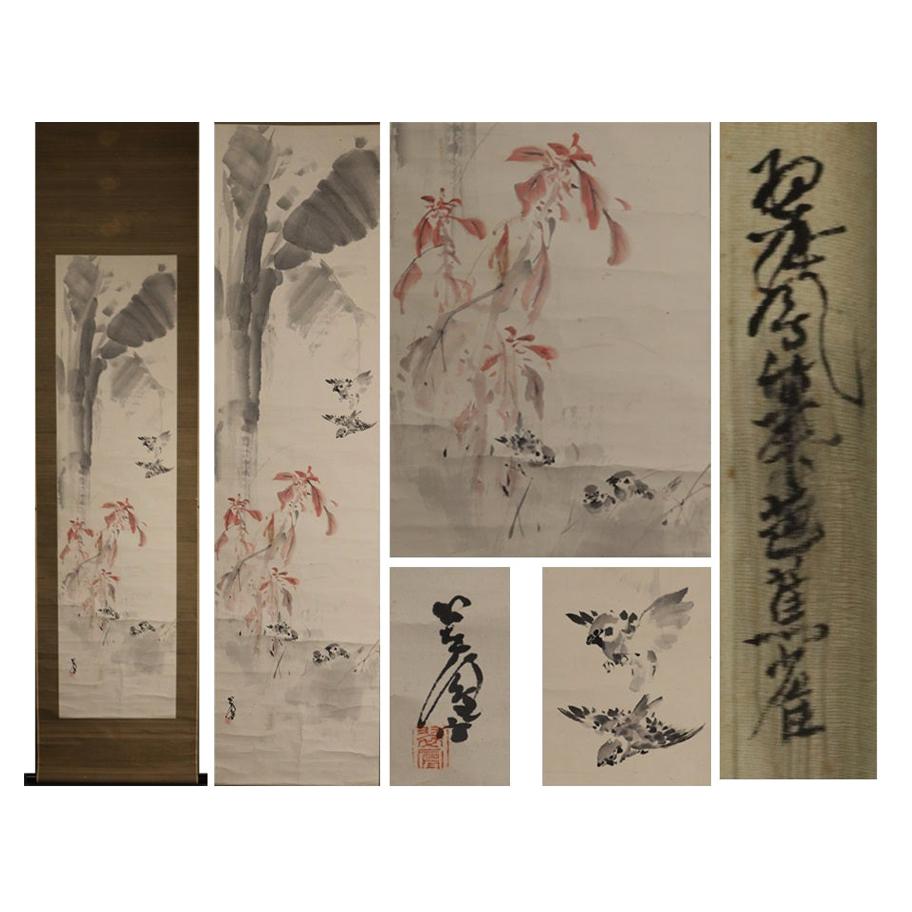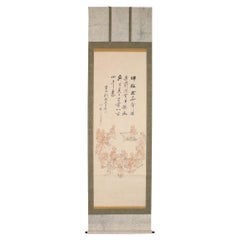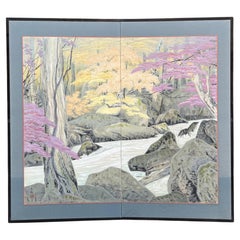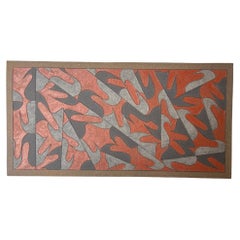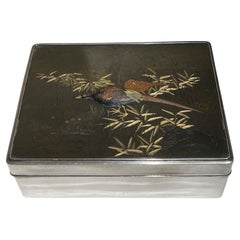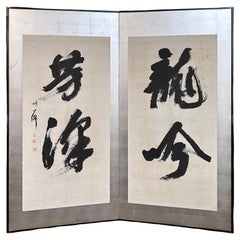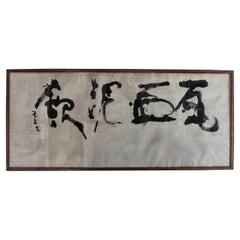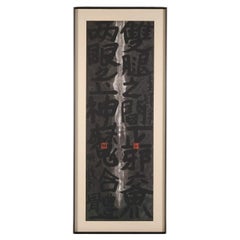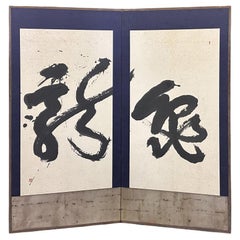Items Similar to Screen Calligraphy, Risking One’s Life Here and There – Sakae Umezu (1926-2013)
Want more images or videos?
Request additional images or videos from the seller
1 of 5
Screen Calligraphy, Risking One’s Life Here and There – Sakae Umezu (1926-2013)
$4,543.34
£3,363.44
€3,800
CA$6,286.85
A$6,931.10
CHF 3,626.13
MX$85,031.78
NOK 45,645.79
SEK 42,686.04
DKK 28,946.07
About the Item
Screen Calligraphy, Risking One’s Life Here and There – Sakae Umezu (1926-2013)
This two-panel folding screen, created by Sakae Umezu, is a powerful and expressive calligraphic work. Each panel, measuring 84.5 x 90 cm, is painted with ink on paper and framed without silk borders, using black lacquered wood with dark patinated metal reinforcements, enhancing the raw strength of the writing. When fully opened, the screen spans nearly 180 cm, commanding a striking visual presence.
The calligraphy, traced in fluid and vigorous black ink, expresses the phrase « Risking one’s life here and there”. The brushstrokes, at times splattered and irregular, reflect an almost visceral intensity, where life seems to spring forth from each gesture. The strokes, alternating between controlled and explosive, reveal a tension between mastery and surrender, echoing the Japanese concepts of impermanence (muj?) and transcendence through total commitment.
Sakae Umezu (1926-2013), known primarily as an actor, also distinguished himself as a scholar and calligrapher. His work often blends philosophical and artistic approaches. Strongly influenced by Zen and the wabi-sabi aesthetic, he was deeply drawn to the tension between the ephemeral and the eternal. In his calligraphy, each stroke becomes a reflection on self-transcendence, the struggle against uncertainty, and humanity’s ability to embrace chaos and find meaning within it.
Through its form and content, this folding screen seems to illustrate the wandering nature of life and the urgency of existence. The two-panel structure may symbolize tension or dialogue, reinforcing the idea that the effort of living, marked by danger or the unknown, is never unilateral. The choice of a folding screen, traditionally used to protect or divide space, becomes here a metaphor for the boundary between stability and flow, survival and transcendence.
- Dimensions:Height: 33.27 in (84.5 cm)Width: 70.87 in (180 cm)Depth: 0.79 in (2 cm)
- Materials and Techniques:
- Place of Origin:
- Period:
- Date of Manufacture:1990
- Condition:Wear consistent with age and use. Small defect to the back of the frame.
- Seller Location:PARIS, FR
- Reference Number:1stDibs: LU6491243523822
About the Seller
5.0
Recognized Seller
These prestigious sellers are industry leaders and represent the highest echelon for item quality and design.
Established in 1982
1stDibs seller since 2022
7 sales on 1stDibs
- ShippingRetrieving quote...Shipping from: PARIS, France
- Return Policy
Authenticity Guarantee
In the unlikely event there’s an issue with an item’s authenticity, contact us within 1 year for a full refund. DetailsMoney-Back Guarantee
If your item is not as described, is damaged in transit, or does not arrive, contact us within 7 days for a full refund. Details24-Hour Cancellation
You have a 24-hour grace period in which to reconsider your purchase, with no questions asked.Vetted Professional Sellers
Our world-class sellers must adhere to strict standards for service and quality, maintaining the integrity of our listings.Price-Match Guarantee
If you find that a seller listed the same item for a lower price elsewhere, we’ll match it.Trusted Global Delivery
Our best-in-class carrier network provides specialized shipping options worldwide, including custom delivery.More From This Seller
View AllRare Japanese painting, Skeletons Studying, Shaku Kaiyin, Japan Meiji Period
Located in PARIS, FR
Skeletons Studying, Shaku Kaiyin, Japan Meiji Period
This ink-on-paper painting, mounted as a scroll with colored paper borders, is titled Skeletons Studying. It portrays a circle of...
Category
Antique Late 19th Century Japanese Paintings and Screens
Materials
Paper
$1,817 Sale Price
20% Off
Two-panel folding screen, Nihonga, Hirai Baisen (1889–1969), early Shōwa era (19
Located in PARIS, FR
Two-panel folding screen, Nihonga, Hirai Baisen (1889–1969), early Shōwa era (1940s)
This two-panel screen is signed by Hirai Baisen (1889–1969), a major Nihonga painter who is only...
Category
20th Century Japanese Paintings and Screens
Materials
Paper
Ceramic Wall Plaque by Japanese artist Masano Asaru, Japan , circa 2000
Located in PARIS, FR
We are pleased to present this wall ceramic artwork by Asano Masaru.
This ceramic plaque shiws remarkable craftsmanship: the clay is hand-formed, carved, and then painted, resulting...
Category
Early 2000s Contemporary Art
Materials
Ceramic
Box signed Katsutoshi Koku, Japan, Meiji period (1868-1912)
Located in PARIS, FR
Box signed Katsutoshi Koku, Japan, Meiji period (1868-1912)
Rectangular silver box bearing the Japanese junjin hallmark, signifying pure silver, made during the Meiji period (1868-1...
Category
Antique Late 19th Century Japanese Decorative Boxes
Materials
Silver
Japan, Large decorative dish by Yasutaka Shimizu and original drawing
Located in PARIS, FR
Yasutaka Shimizu was born in 1947 in Kyoto.
The son of Uichi Shimizu, a living national treasure, he was immersed from a young age in a world where art and tradition meet.
After gra...
Category
Late 20th Century Decorative Dishes and Vide-Poche
Materials
Ceramic
Japan, Rare Vase by Kanzan Shinkai, born in 1912
Located in PARIS, FR
Vase by Kanzan Shinkai,born in 1912
This vase is a fine example of Kanzan Shinkai's work. It features an intricate design, with raised circular patterns, using contrasting colors suc...
Category
Mid-20th Century Japanese Vases
Materials
Ceramic
You May Also Like
Taisho Period Calligraphy Screen: The Dragon's Song
Located in Fukuoka, JP
Taisho Period Calligraphy Screen: The Dragon's Song (2/2)
Period: Taisho
Size: 174 x 172.5 cm (68.5 x 67.9 inches)
SKU: PTA77
This calligraphy screen from the Taisho period is ...
Category
20th Century Japanese Taisho Paintings and Screens
Materials
Silver Leaf
Gaboku Ogawa 'Abstract Japanese Calligraphy' MOMA 1953
Located in Sharon, CT
A very important work, both historically and aesthetically-"Getting madly drunk out of an earthenware goblet", by Gaboku Ogawa c.1953,
exhibited in the Museum of Modern Art show "Abstract Japanese...
Category
Mid-20th Century Japanese Mid-Century Modern Paintings and Screens
Materials
Paper
Framed Chinese Ink Art Calligraphy by Fung Ming Chip
Located in Atlanta, GA
A large contemporary ink work by Chinese artist Fung Min Chip (China, 1951-). The calligraphic work was created on traditional Chinese Xuan paper and features a vertical pair of coup...
Category
21st Century and Contemporary Hong Kong Modern Paintings and Screens
Materials
Wood, Paper
A turtle and a dragon calligraphy Screen
Located in Fukuoka, JP
"Immerse yourself in the timeless symbolism of the East with our dramatic calligraphy screen, adorned with characters representing a turtle and a dragon.
In Eastern culture, the tu...
Category
20th Century Japanese Paintings and Screens
Materials
Silver Leaf
Japanese Two Panel Screen: Mu (Nothing)
Located in Hudson, NY
Calligraphy reads: Mu (Nothing). Ink on silver in a black lacquered wooden trim. Seal is illegible.
Category
Early 20th Century Japanese Paintings and Screens
Materials
Silver
Artists Suiho Yano Showa Period Scroll Japan 20c Artist Nihonga
Located in Amsterdam, Noord Holland
As you can see, it is a work of "Basho / Sparrow" drawn by Midori Yano.
Under Basho, this work skillfully depicts the appearance of sparrows forming a flock and singing food.
«Su...
Category
20th Century Japanese Taisho Paintings and Screens
Materials
Silk
$1,138 Sale Price
20% Off
More Ways To Browse
Japanese Wood Room Divider
Japanese Divider Screen
Japanese Room Divider Screens
Japanese Calligraphy Screen
Two Panel Folding Screen
18th Century 4 Fold Screen
18th Century Fire Screen
Antique Privacy Screens
Chinese Screen With Birds
European Folding Screen
Gold Coromandel Screen
Hunting Screen
Piero Fornasetti Panel
Reverso Room Divider
Small Room Divider
Spanish Folding Screen
8 Panel Chinese Screen
Aalto Screen 100
